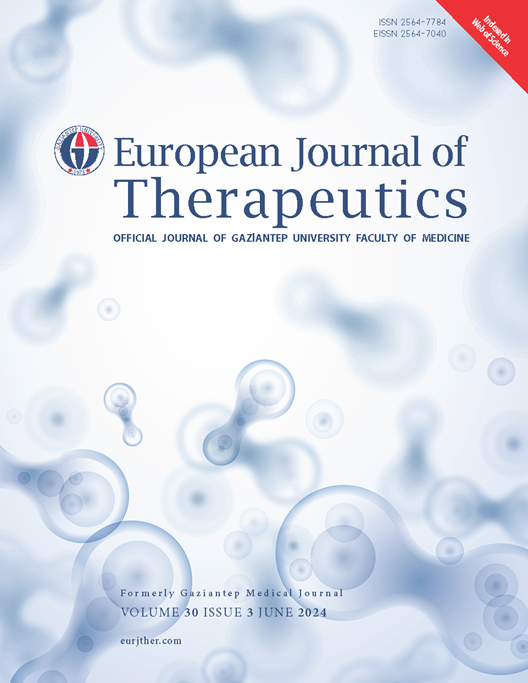Evaluation of Patients with Postoperative Pancreatic Fistula After Isolated Splenectomy: A Retrospective Study
DOI:
https://doi.org/10.58600/eurjther2081Keywords:
complication, drainage, pancreatic fistula, splenectomyAbstract
Objective: Postoperative pancreatic fistula (POPF) is a potentially life-threatening complication. This complication occurs not only after pancreatic surgery but may also arise after other abdominal procedures. In this study, we aimed to determine the incidence and risk factors of POPF in patients undergoing isolated splenectomy.
Methods: Patients who underwent isolated splenectomy were identified. POPF was defined according to the 2016 update of International Study Group of Pancreatic Fistula classification and graded as biochemical leak (BL), grade B fistula, and grade C fistula. Characteristics and perioperative variables were compared between patients who had pancreatic fistula and those who have not.
Results: The study cohort consisted of 59 patients with median age 38.9 years, and 50.8% male. The indication was trauma in 18 (30.5%) patients. Twenty (33.9%) patients were operated upon emergently. Thirty-seven (62.7%) splenectomies were performed open. Out of all patients, 14 (23.7%) developed any sort of pancreatic fistula. BL occurred in 11 (18.6%) patients and 3 (5.1%) patients developed a grade B fistula. Comparison of patients with and without BL/POPF demonstrated no significant differences in demographics, surgical indication, operative method, surgical approach, or postoperative outcome.
Conclusions: Despite higher incidence of pancreatic leak, the rate of clinically relevant fistula is relatively low. In this study, we did not identify any factors associated with BL/POPF. Thus, further studies are needed on pancreatic fistula after splenectomy.
Metrics
References
Somasundaram SK, Massey L, Gooch D, Reed J, Menzies D (2015) Laparoscopic splenectomy is emerging 'gold standard' treatment even for massive spleens. Ann R Coll Surg Engl. 97(5):345-348. https://doi.org/10.1308/003588414X14055925060479
Chand B, Walsh RM, Ponsky J, Brody F (2001) Pancreatic complications following laparoscopic splenectomy. Surg Endos. 15(11):1273-1276. https://doi.org/10.1007/s004640080054
Misiakos EP, Bagias G, Liakakos T, Machairas A (2017) Laparoscopic splenectomy: Current concepts. World J Gastrointest Endosc. 9(9):428-437. https://doi.org/10.4253/wjge.v9.i9.428
Bhandarkar DS, Katara AN, Mittal G, Shah R, Udwadia TE (2011) Prevention and management of complications of laparoscopic splenectomy. Indian J Surg. 73(5):324-330. https://doi.org/10.1007/s12262-011-0331-5
Mehdorn AS, Schwieters AK, Mardin WA, et al (2022) Pancreatic fistula and biochemical leak after splenectomy: Incidence and risk factors-a retrospective single-center analysis. Langenbecks Arch Surg. 407(6):2517-2525. https://doi.org/10.1007/s00423-022-02531-7
Tsutsumi N, Tomikawa M, Akahoshi T, et al (2016) Pancreatic fistula after laparoscopic splenectomy in patients with hypersplenism due to liver cirrhosis: effect of fibrin glue and polyglycolic acid felt on prophylaxis of postoperative complications. Am J Surg. 212(5):882-888. https://doi.org/10.1016/j.amjsurg.2015.12.028
Shen Y, Guo B, Wang L, et al (2020) Significance of amylase monitoring in peritoneal drainage fluid after splenectomy: A clinical analysis of splenectomy in 167 patients with hepatolenticular degeneration. Am Surg. 86(4):334-340. https://doi.org/10.1177/000313482008600429
Bassi C, Marchegiani G, Dervenis C, et al (2017) The 2016 update of the International Study Group (ISGPS) definition and grading of postoperative pancreatic fistula: 11 Years After. Surgery. 161(3):584-591. https://doi.org/10.1016/j.surg.2016.11.014
Clavien PA, Barkun J, de Oliveira ML, et al (2009) The Clavien-Dindo classification of surgical complications: five-year experience. Ann Surg. 250(2):187-196. https://doi.org/10.1097/SLA.0b013e3181b13ca2
The jamovi project (2022). Jamovi (Version 2.3) [Computer software]. Retrieved from: https://www.jamovi.org.
Kindel TL, Dirks RC, Collings AT, et al (2021) Guidelines for the performance of minimally invasive splenectomy. Surg Endosc. 35(11):5877-5888. https://doi.org/10.1007/s00464-021-08741-2
Winslow ER, Brunt LM (2003) Perioperative outcomes of laparoscopic versus open splenectomy: a meta-analysis with an emphasis on complications. Surgery. 134(4):647-655. https://doi.org/10.1016/s0039-6060(03)00312-x
Buzelé R, Barbier L, Sauvanet A, Fantin B (2016) Medical complications following splenectomy. J Visc Surg. 153(4):277-286. https://doi.org/10.1016/j.jviscsurg.2016.04.013
Taniguchi Y, Kurokawa Y, Mikami J, et al (2017) Amylase concentration in drainage fluid as a predictive factor for severe postoperative pancreatic fistula in patients with gastric cancer. Surg Today. 47(11):1378-1383. https://doi.org/ 10.1007/s00595-017-1521-y
Saxena A, Chua TC, Yan TD, Morris DL (2010) Postoperative pancreatic fistula after cytoreductive surgery and perioperative intraperitoneal chemotherapy: incidence, risk factors, management, and clinical sequelae. Ann Surg Oncol. 17(5):1302-1310. https://doi.org/10.1245/s10434-009-0898-2
Kato K, Tate S, Nishikimi K, Shozu M (2013) Management of pancreatic fistulas after a splenectomy as part of cytoreductive surgery for ovarian cancer. Int J Gynecol Cancer. 23(8):1506-1511. https://doi.org/10.1097/IGC.0b013e3182a0fa66
Zhu QL, Wu W (2021) Comparison of clinical efficacy of laparoscopic splenectomy versus open splenectomy for idiopathic thrombocytopenic purpura: A meta-analysis. Medicine. 100(4):e24436. https://doi.org/10.1097/MD.0000000000024436
Milosavljevic V, Tadic B, Grubor N, Eric D, Reljic M, Matic S (2019) Analysis of the surgical treatment of the patients operated on by using laparoscopic and classic splenectomy due to benign disorders of the spleen. Turk J Surg. 35(2):111-116. https://doi.org/10.5578/turkjsurg.4324
Fujinaga A, Ohta M, Endo Y, et al (2021) Clinical significance of splenic vessels and anatomical features in laparoscopic splenectomy. J Laparoendosc Adv Surg Tech. 31(6):632-637. https://doi.org/10.1089/lap.2020.0576
Davies IL, Cho J, Lewis MH (2014) Splenectomy results from an 18-year single centre experience. Ann R Coll Surg. 96(2):147-150. https://doi.org/10.1308/003588414X13814021677593
Arnold P, Belchos J, Meagher A, et al (2022) Postoperative pancreatic fistula following traumatic splenectomy: A morbid and costly complication. J Surg Res. 280:35-43. https://doi.org/10.1016/j.jss.2022.07.005
Targarona EM, Espert JJ, Bombuy E, et al (2000) Complications of laparoscopic splenectomy. Arch Surg. 135(10):1137-1140. https://doi.org/10.1001/archsurg.135.10.1137
Rodríguez-Luna MR, Balagué C, Fernández-Ananín S, Vilallonga R, Targarona Soler EM (2021) Outcomes of laparoscopic splenectomy for treatment of splenomegaly: A systematic review and meta-analysis. World J Surg. 45(2):465-479. https://doi.org/10.1007/s00268-020-05839-x
Alobuia WM, Perrone K, Iberri DJ, Brar RS, Spain DA, Forrester JD (2020) Splenectomy for benign and malignant hematologic pathology: Modern morbidity, mortality, and long-term outcomes. Surg Open Sci. 2(4):19-24. https://doi.org/10.1016/j.sopen.2020.06.004
Bassi C, Dervenis C, Butturini G, et al (2005) Postoperative pancreatic fistula: an international study group (ISGPF) definition. Surgery. 138(1):8-13. https://doi.org/10.1016/j.surg.2005.05.001
Downloads
Published
How to Cite
Issue
Section
License
Copyright (c) 2024 European Journal of Therapeutics

This work is licensed under a Creative Commons Attribution-NonCommercial 4.0 International License.
The content of this journal is licensed under a Creative Commons Attribution-NonCommercial 4.0 International License.


















